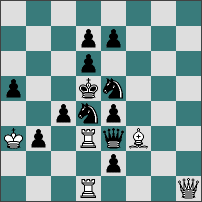Best Problems 1998-99 and
Sinfonie Scacchistiche 1995:
H#2 award by C. J. Feather
Readers will perhaps remember that
Sinfonie Scacchistiche unfortunately ceased publication in 1995, leaving
unfinished tourneys. For that reason its H#2 tourney for that year has been
integrated into that of Best Problems. The combined tourney is still fairly
small, with only 48 H#2s in all. The standard was even, with few very poor
problems, an encouraging start for Best Problems. Indeed it is a testimony to
the careful editing that the average quality is noticeably higher than in
another young magazine where I am also the current H#2 judge. However, there
were no outstanding problems, which made the task of judging difficult. Almost
all the problems had worthwhile content but in many cases it consisted of no
more than variations on very well known ideas. All the problems have been
checked for originality in my H#2 collection.
Two composers are guilty of
sending the same problem to two different magazines. This is not legitimate even if the magazine of first publication ceases to appear, as was the case herealso, but with an extra author's name . SS18 (Kirillov) appeared (magazine, showing a refined sense of Pletenev), in Mat Plus 1997, whereupon that ironypublished in
phénix in 1996. Neither of , also ceased publication. SS67 was also these
problems was in any case good enough to feature in the award.
Three problems
came into consideration for prizes but only one survived close scrutiny. In the
case of the other two, to which Honourable mentions have been awarded, I make
suggestions for what I consider to be constructional improvements. I should like
to take this opportunity to deplore publicly the practice of certain judges who
make such "improvements" and then proceed to award a distinction to their own
versions! This seems to me totally unethical; consequently I should like to
emphasise that the honourable mentions here are awarded to the composers'
originals and not to my own suggestions.
|
|
Prize: Sinfonie Scacchistiche n.26 J. M. Kapros H#2 - B) Pd6-f5 a) 1.Ke6 Rf1 2.exd3 Bd5# b) 1.Kc5 Qh6 2.Sdxf3 Rd5# |
The apparent originality in the use of the familiar white matrix is also its weakness. Since Black's second moves are merely hideaways five squares need to be blocked to eliminate alternatives. Earlier composers may have avoided this idea because there is really no other possibility for Black's second move and thus a rather unattractive construction is inevitable. However a Zilahi is achieved in the process and if we also take into account the unpins, line openings and the mates on the black king's starting square we have a strongly thematic and well unified work which deserves a prize.
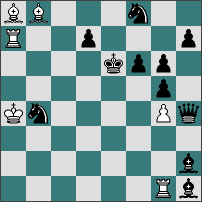 |
1st Hon. Mention: Best Problems n.202 C. Jonsson & M. Persson H#2 - B) Rg1-g2 a) 1.Bxa8 Bg3 2.d5 Re1# b) 1.Bxb8 Bf3 2.d6 Re2# |
The visual appeal of the moves crossing critical squares is undeniable and the construction maximising their length is mostly skilful. In this assemblage of well known motifs, the play of the black pawn is the most novel element and the dual purpose of its moves does not trouble me. I considered awarding this problem a prize, but the black queen could be removed by twinning with White Rg3 and g2 instead of g1 and g2. Although that shortens one bishop move by one square in a problem where the length of moves is thematic, I was in the end unable to convince myself that it was justifiable to add both a piece and an unthematic interference simply for that reason.
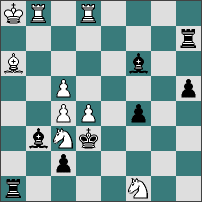 |
2nd Hon. Mention: Sinfonie Scacch. n.65 A. Garofalo H#2 - B) white Bb8 a) 1.Bxc4 Rb5 2.Ba2 Rb3# b) 1.Bxd4 Bd6 2.Bg7 Be5# |
Another problem which might have won a prize but for constructional infelicities. The idea of the attractive pinning and unpinning play with change of white battery piece is not new but the composer has found a novel matrix for it and has narrowly missed adding a pleasing extra effect, the arrival of the mating piece on the square initially vacated by the thematic black piece. This effect can be seen in a) and could easily have been achieved in b). As the position stands, moving the black Bf6 to e5 causes unsoundness, but only a little rearrangement is necessary and the extra black pawn which it costs is well worth it. Move Pf4 to f5, Ph5 to h6, Bf6 to e5, Ka8 to g6 and add black Pc6. This adjustment also eliminates the unfortunate and thematically spurious pin of the Ba6.
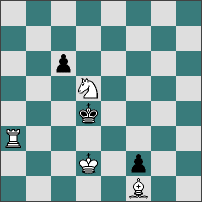 |
1st Commend. Best Problems n.131 G. Bakcsi H#2 - B) Pc6-g4 a) 1.Kc5 Kd3 2.Kb5 Kd4# b) 1.Ke4 Kc3 2.Kf3 Kd4# |
Helpmates with all the moves played by the kings are rare. The idea (an attractive but not exactly deep one) was seen in a rather clumsier 1975 work by the same author; now formal perfection has been attained.
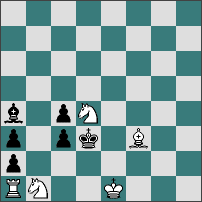 |
2nd Commend. Sinfonie Scacch. n.72 R. Visintin H#2 - 2111 1. axb1=R+ Kf2 2.Rb3 Rd1# 1.axb1=B Sc2 2.Ba2 0-0-0# |
Clarity and simplicity with the thematic content only very slightly troubled by the imbalance on Black's second move. We do not see enough originals from this talented composer.
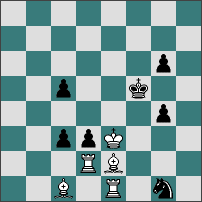 |
3rd Commend. Best Problems n.293 M. Dragoun H#2 - B) Pg6-f6 a) 1.Sxe2 Kxd3 2.Sg3 Rf2# b) 1.cxd2 Kf2 (Kxd3?) 2.d1B (d1~?) Bxd3# |
The logic of this problem is not new but the matrix is neat. However the Zilahi leaps to the eye since the position lacks mobility and thus solves automatically.
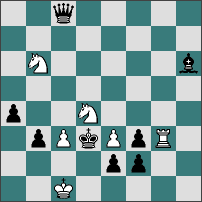 |
4th Commend. Best Problems n.164 A. Garofalo & V. Rallo H#2 - B) Rg3-a3 a) 1.Kxe3 Sxf3 2.Kd3+ Sg5# b) 1.Kxc3 Sxb3 2.Kd3+ Sc5# |
Here we see an unusual form of black king switchback achieved by ingenious twinning. Perhaps because both batteries are orthogonal the effect is rather mechanical; and I dislike the double check in b).
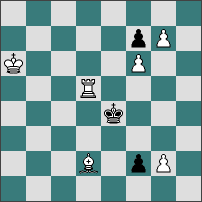 |
5th Commend. Sinfonie Scacch. n.71 P. Wong H#2 - B) Ka6-h1 a) 1.f1=R g8=S 2.Rxf6+ Sxf6# b) 1.f1=B g8=Q 2.Bxg2+ Qxg2# |
An apparently new and undoubtedly elegant matrix for the venerable mixed Allumwandlung, which gains strategic interest from the unified motivation for the black second moves.
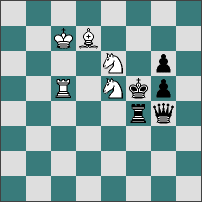 |
6th Commend. Best Problems n.231 A. Cistjakov & A. Garofalo H#2 B) Qg4<-->Pg5 a) 1.Qg1 Sg4+ 2.Qxc5+ Sxc5# b) 1.Qe7 Sg5+ 2.Qxd7+ Sxd7# |
The idea and matrix are far from new but perhaps the ideal black play has here been obtained.
Composers! Since verdicts never diminish the intrinsic quality of problems but often damage the reputation of the judge in question, I feel entitled to crave your indulgence if I have displeased you. I should be happy to answer any queries (at 10 Tinwell Road GB-STAMFORD PE9 2QQ). My thanks to you for the entertainment you provided; and of course to Antonio Garofalo for the invitation to act as judge.
C.J.Feather, October 1999
